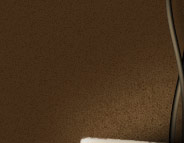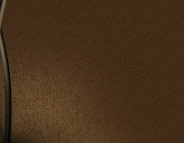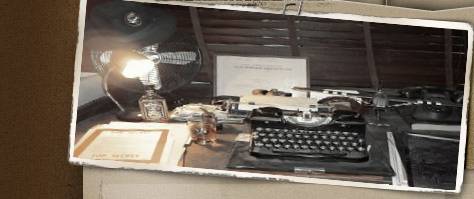 |
| |

Item Description: Captain
Harwick's Silver Bars
Introduction:
Subject of discussion is why
Captain John Kiley of 3rd Bn./506th
was picked by the sniper that
shot him. In George Koskimaki's
Hell's Highway, we read the view
of Lt. Santasiero of "I"
Company: “Capt. John Kiley
came up to me, looking like an
officer – bars, map case and
binocs in full view. (Kiley was
a close friend and I was
concerned.) I said ‘God damn,
Kiley! What in hell are you
doing up here? You shine like a
f---ing officer. You know the
Krauts are waiting to kill
officers. Please get your ass to
the rear.’ As can be read in
Case File # 1, Kiley was
killed shortly after this
happened. Others were aware that
their officer accoutrements made
them likely targets. This is how
the badge of authority of one
officer in the 506th found its
way into a Dutch silver-cabinet.
The Story: This is a
story about Captain Robert F.
Harwick.

Captain Harwick
during paratrooper
training in the
United States in 1942
|
|
This commander of "H" Company on
D-Day, spent a short time as a
Prisoner of War in Normandy. This is
what Mark Bando wrote about Captain
Harwick on page 61 of his book
"Avenging Eagles: “The men in
Company H were well aware that their
C.O. was trapped in an unhappy
marriage. While in England, this
captain was romancing a certain Red
Cross girl, and every man in the
company knew about it. There was no
moral condemnation of the captain in
the view of his troops, because they
knew of his marital discord. What
few of them realized was that this
dame captain was also the love
object of a certain Lady of
aristocratic standing in Ramsbury.
She would offer to divorce her
husband, if Captain H- would have
her on a full-time basis. This
proposal was rejected and the
captain in question did return to
his wife at war’s end. However, his
unhappy domestic life may have
contributed to his sudden death by
cardiac arrest, only fifteen years
after the war ended.” |
|
The author Mark Bando read this
Battle Relic File and on October
25th, 2007, he wrote to Battle
Detective.com:
"When the Bulge started, Harwick
was on leave to Paris and he drove
up to Bastogne a little behind the
main columns. He went to Noville for
some reason, (I'm not sure if he was
already assigned to 1st Bn or
not). When a tank retriever parked
in front of the house which was
LTC LaPrade's 1st Bn
506th C.P., a German shell came in
the 2nd flr window, killed LaPrade
and seriously wounded
Maj. Desobry from the 10th
AD. When this happened, Harwick was
in the room next door-at that time
he moved over and took command of
1st Bn 506th, as acting C.O.-a
position he held until the 9th day
of January, 1945, when he was
seriously wounded and evacuated. If
you read my latest book, you'll find
Harwick's account of 1st Bn's sweep
through the woods between Luzery and
the Halt station-same battle
Burgett describes in 'Seven
Rds to Hell'. This makes perfect
sense, because Harwick was commander
of Burgett's (1st) Bn at the time."
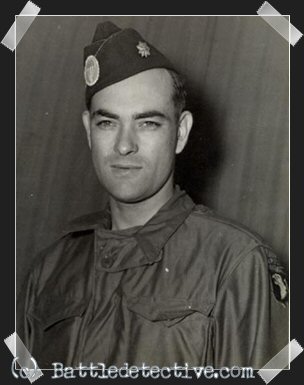
Major Harwick |
|
After the fighting in the towns
along Hell's Highway was over,
Harwick wrote to his Red Cross Girl
in England: "By early afternoon,
the city was ours and we truly
entered as conquerors and
liberators. Those receptions are a
thing to beggar description. If you
can imagine all the spectators at an
inaugural parade to suddenly swarm
into, under and over the ranks –
carrying fruit, pitchers of beer,
sandwiches of dark bread or just
waving Dutch flags or bits of orange
cloth or just running, trying to
touch you, everyone happily yelling
at the tops of their lungs, begging
for a souvenir – the flag armband,
the eagle insignia, a bar or badge
or anything” |
|
(Page 127 of Hell's Highway) |
|
On page 33 of Jan van Hout's
collection of "Memories of September
1944" we read Jos Klerkx's
recollections of what happened on
September 18th 1944. Jos was 12
years old at the time: “An
American showed us chewing gum
["Kauwgum" in Dutch] and
we had to repeat after him in
English: ‘chewing gum’. We just
couldn’t, which he enjoyed.
|
|

Cartoon from "The
Epic of the 101st Airborne"
proves that Jos's
trouble with the English
language wasn't
uncommon among Dutch kids.
|
|
We also got our first souvenirs.
I got bullets which a soldier took
from a machine gun belt, with the
message ‘souvenir for Hitler’. Also
we got armbands with the American
flag which they wore, etcetera and
chocolate.
Invasion Armbands
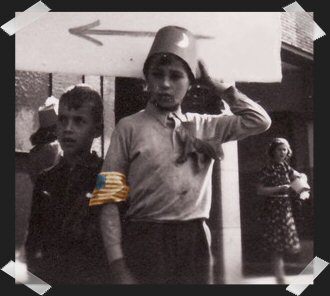
Jos wasn't the only
Eindhoven boy who got
a souvenir American
flag invasion brassard.
This kid is
photographed at the Texaco service
station on Wal.
By the way, not all the discarded
invasion armbands ended up as
souvenirs, as this photograph shows.
Note the US flag armband tied in the
jeep's grill:
(click on the image
to enlarge)

This photograph was
taken in Veghel when elements of the
British 30th Corps sped through
town.
This jeep belonged to
Regimental Headquarters Company of
the 501st Parachute Infantry
Regiment.
Also note the
anti-decapitation device, welded on
the bumper.
It was meant to
protect the jeep's occupants against
wires strung across roads.
In Veghel the bar
caught some of the paper party ribbons
thrown at Allied vehicles by
the cheerful Dutch citizens.
Finally, this
photograph, taken from the September
29th 1944 issue of YANK Magazine,
pictures
Staff Sergeant Red
Kimbrough with his own flag to show
the enemy where he's from:

Jos continues:
One moment during a lull
in the fighting a soldier with an,
as it appeared later, American
captain's badge, sat on a chair which
was put out for that purpose. I
wanted to know what it was, but he
took the silver pin from his collar
en said something like this is for
you. I have carefully kept this pin
to this day. Much later I also read
the story of captain Robert F. Harwick in the book of the Hell’s
Highway in which is described, how
he lost his captains badge. From
another soldier I got a dagger which
he carried on his ankles. My Mother
made me return it.” |
|
Battledetective.com started an
investigation and made a close study
of a photograph taken of Captain
Harwick in the center of Eindhoven
on that 18th of September 1944 on
Demer. This street is a few miles
south of Vlokhovense Weg and
therefore must have been taken on a
later moment in time then his
encounter with Jos Klerkx. This
picture is also in our
Now&Then-section.
According
to U.S. Army uniform regulations,
effective since August 1942, this is
how Harwick should have worn his
captain's bars:
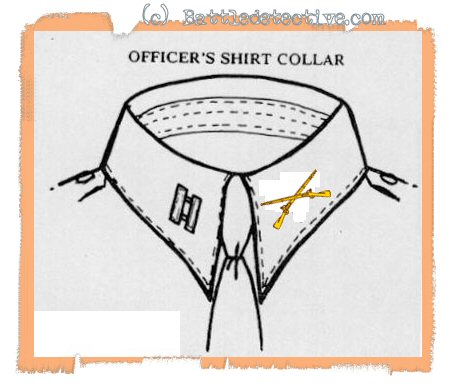 |
|
In the picture taken on Demer,
however.....
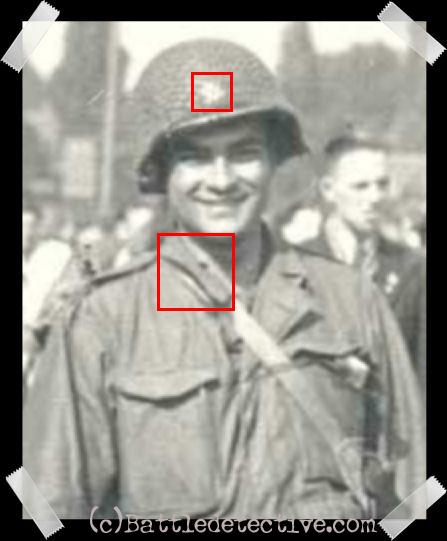
...the
bars are missing! Harwick does have
captain's bars painted on his steel
paratrooper helmet. His shirt collar
sticks out of his M43 combat jacket.
And although according to the Order
of Battle for the 506th regiment for
Market Garden, the regiment counted
about 15 captains (including the
chaplain), this makes Jos Klerkx's story convincing. It
is very likely that it was Captain Harwick who gave him the bar.
|
|
Battledetective found Jos Klerkx
and visited him and his wife in their home in North
Brabant. Over a very important
ingredient for good detective work -
a nice, hot cup of coffee - Jos
proudly showed the silver captain's
bars he kept for over 62 years.
|
 |
|
|
|
These are the bars:


(click on the
pictures to enlarge)
One of the reasons that the renowned
author Mark Bando wrote us is, that
earlier we had posted a different
photograph of a man which, we
assumed, showed Captain Harwick.
This is the complete photograph and
we thought that Harwick was the man
on the right:
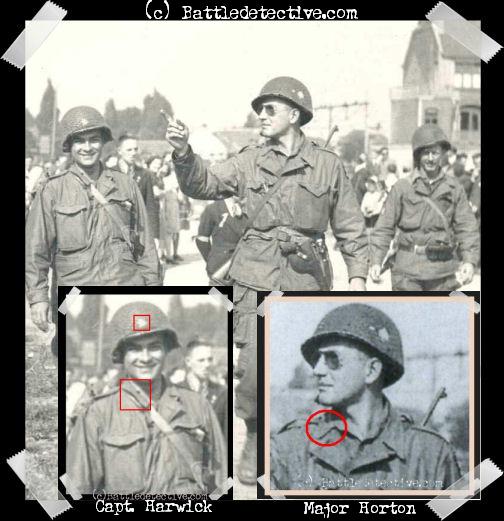
Mark Bando wrote us:
"Officers in the 506th were
frequently moved from one battalion
to another and another example is
Major Oliver Horton,
who started at Toccoa with
2nd Bn, (Dick
Winters, Nixon, Strayer, and the
rest). After Normandy,
Horton was put in command
of 3rd Bn 506th
in time to lead them into Holland.
The photo you show of an officer
walking thru Eindhoven on 18
September, 1944, with his head
inclined to the side (showing his
helmet stencil), is not
Bob Harwick, it is Ollie Horton.
Horton,
who was later KIA 5-October, 1944 at
Opheusden near the RR station),
was 3/506th commander,
at the time that photo was made in
Eindhoven. Captain Harwick was
probably XO of 3/506th
at the time that photo was made.
I assume you have the complete photo
in question? There is another
officer standing on the left side of
the photo, facing directly at the
camera and smiling. That man was
Robert Harwick.
So if an officer gave someone in
Eindhoven his captain's bars on 18
September, it was
not Ollie Horton,
because he was a Major
(gold leaf rank
insignia), at the time.
It could have been
Bob Harwick, but it could also have
been any other 506th captain who
entered Eindhoven that day. [...]
It appears that Ollie might have
given his major's leaf to someone as
well."
(click on the image
to enlarge)

Rank Insignia, Major
U.S. Army
Thanks, Mark Bando, for sharing this
much appreciated additional
information!
It made this portrait of Capt.
Harwick more accurate and detailed! |
|
|
|
